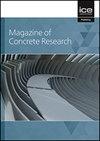Shear thickening of cementitious suspensions: effect of high solid volume fraction and hydration
IF 1.8
4区 工程技术
Q3 CONSTRUCTION & BUILDING TECHNOLOGY
引用次数: 0
Abstract
During pumping of concrete, the lubrication layer (LL) formed at the interface of the concrete and the pipe plays a crucial role in facilitating the process. Shear thickening in this layer affects the concrete pumping significantly. However, very few studies are available in understanding the onset and intensity of shear thickening behavior of the lubrication layer. In this study, the effect of solid volume fraction (SVF), superplasticizer (SP) dosage, supplementary cementitious materials (SCMs) and hydration on the shear thickening (Continuous and discontinuous) behavior of cementitious suspensions are investigated. Results show that an increase in SVF, reduces the shear thickening intensity in case of cement (OPC) systems whereas the intensity is amplified for systems with fly ash (FA) and ground granulated blast furnace slag (GGBS). An increment in the SP dosage results in an early onset and increases the shear thickening intensity, regardless of the binder used. GGBS based systems show the highest shear thickening intensity, followed by OPC and FA based systems. Based on the results, it is evident that the optimization of SP dosage for OPC based systems needs to be carried out based on the structural build-up, while for FA or GGBS based systems, the SP optimization needs to be carried out based on shear thickening behavior with respect to hydration.胶凝悬浮液的剪切增稠:高固相体积分数和水化的影响
在混凝土泵送过程中,在混凝土与管道界面处形成的润滑层(LL)对泵送起着至关重要的促进作用。该层剪切增厚对混凝土泵送影响较大。然而,关于润滑层剪切增厚行为的发生和强度的研究很少。在本研究中,研究了固体体积分数(SVF)、高效减水剂(SP)用量、补充胶凝材料(SCMs)和水化对胶凝悬浮液剪切增稠(连续和间断)行为的影响。结果表明,在水泥(OPC)体系中,SVF的增加降低了剪切增稠强度,而在粉煤灰(FA)和磨粒高炉渣(GGBS)体系中,SVF的增加则放大了剪切增稠强度。无论使用何种粘结剂,SP用量的增加都会导致早期发作并增加剪切增稠强度。GGBS基体系的剪切增厚强度最高,其次是OPC和FA基体系。综上所述,基于OPC的体系的SP用量优化需要基于结构累积进行,而对于基于FA或GGBS的体系,SP的优化需要基于水化的剪切增稠行为进行。
本文章由计算机程序翻译,如有差异,请以英文原文为准。
求助全文
约1分钟内获得全文
求助全文
来源期刊

Magazine of Concrete Research
工程技术-材料科学:综合
CiteScore
4.60
自引率
11.10%
发文量
102
审稿时长
5 months
期刊介绍:
For concrete and other cementitious derivatives to be developed further, we need to understand the use of alternative hydraulically active materials used in combination with plain Portland Cement, sustainability and durability issues. Both fundamental and best practice issues need to be addressed.
Magazine of Concrete Research covers every aspect of concrete manufacture and behaviour from performance and evaluation of constituent materials to mix design, testing, durability, structural analysis and composite construction.
 求助内容:
求助内容: 应助结果提醒方式:
应助结果提醒方式:


